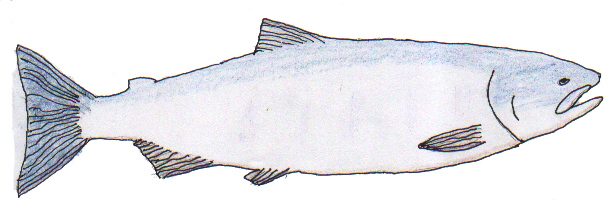 This collection of student work is from Frank Keim's classes. He wants to share these works for others to use as an example of culturally-based curriculum and documentation. These documents have been OCR-scanned and are available for educational use only.
This collection of student work is from Frank Keim's classes. He wants to share these works for others to use as an example of culturally-based curriculum and documentation. These documents have been OCR-scanned and are available for educational use only.Special | A | B | C | D | E | F | G | H | I | J | K | L | M | N | O
P | Q | R | S | T | U | V | W | X | Y | Z | ALL
The Chum Salmon:The Chum Salmon
(Oncorhynchus keta) (Aluyak)
Chum salmon have the widest distribution of all the Pacific salmon. They range from south of the Sacramento River in California, west to an island near Japan, then up to the Arctic Ocean and all the way up the Yukon River to Canada. Chum are also known as dog salmon. In the ocean they are metallic greenish-blue on the top, and the rest is silver colored. Chums have fewer but larger gillrakers than other salmon. After they reach freshwater they turn green, black, red and purple. Chum salmon often spawn in small side channels and other areas where their eggs will survive. Some even travel all the way up into Canada to spawn. They deposit their eggs in redds located primarily in upwelling spring areas and streams. The females can lay up to 2,700 eggs. Chum are similar in their habits to the Pink salmon, but they don't move down to the ocean in the spring like the Pinks. Before they move to the ocean they feed on little insects. Then in late summer they bunch up into schools and move down to the ocean where they eat zooplankton. By fall they move into the Gulf of Alaska. Chum spend three to six years in the ocean before returning to their spawning grounds. They vary in size from 4 to 30 pounds. Sport fishermen only occasionally hook a Chum salmon. In the last five years an average of five million Chum salmon were caught worth over 15 million dollars. Until recent years Chum salmon were the least utilized of all the Pacific salmon as a commercial species. The Department of Fish and Game has recently begun to build hatcheries primarily for Chum salmon production. By Willie Paul Fitka | |
|




